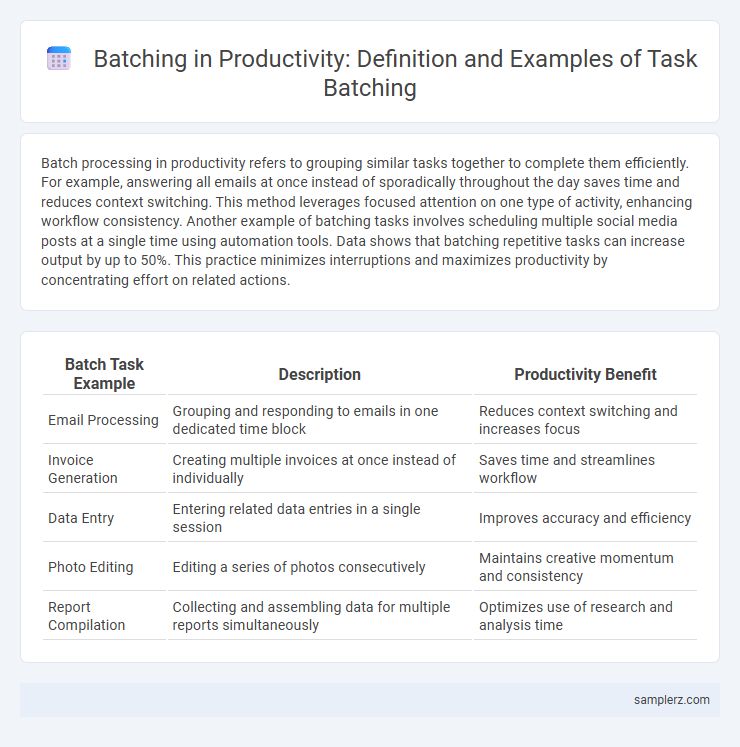Batch processing in productivity refers to grouping similar tasks together to complete them efficiently. For example, answering all emails at once instead of sporadically throughout the day saves time and reduces context switching. This method leverages focused attention on one type of activity, enhancing workflow consistency. Another example of batching tasks involves scheduling multiple social media posts at a single time using automation tools. Data shows that batching repetitive tasks can increase output by up to 50%. This practice minimizes interruptions and maximizes productivity by concentrating effort on related actions.
Table of Comparison
| Batch Task Example | Description | Productivity Benefit |
|---|---|---|
| Email Processing | Grouping and responding to emails in one dedicated time block | Reduces context switching and increases focus |
| Invoice Generation | Creating multiple invoices at once instead of individually | Saves time and streamlines workflow |
| Data Entry | Entering related data entries in a single session | Improves accuracy and efficiency |
| Photo Editing | Editing a series of photos consecutively | Maintains creative momentum and consistency |
| Report Compilation | Collecting and assembling data for multiple reports simultaneously | Optimizes use of research and analysis time |
Understanding Task Batching: A Productivity Game-Changer
Task batching groups similar activities such as email responses, report writing, and phone calls to minimize context switching and enhance concentration. By dedicating specific time blocks to related tasks, cognitive load decreases, leading to faster completion and improved quality. This method boosts overall productivity by creating a focused workflow that reduces distractions and procrastination.
Common Everyday Examples of Task Batching
Batching common everyday tasks like answering emails, paying bills, and grocery shopping enhances productivity by minimizing context switching. Grouping similar activities such as meal prepping for the week or scheduling all phone calls within a set time block reduces cognitive load and saves time. This focused approach leverages task batching to streamline daily routines and improve efficiency.
Batch Processing Emails for Efficiency
Batch processing emails improves productivity by grouping similar messages for simultaneous handling, reducing constant inbox interruptions. Automating email sorting and replies through predefined rules accelerates response time and minimizes decision fatigue. This method enhances workflow efficiency by allowing dedicated focus periods for email management, freeing time for higher-priority tasks.
Grouping Similar Administrative Tasks
Grouping similar administrative tasks, such as responding to emails, scheduling meetings, and processing invoices, into dedicated time blocks enhances focus and minimizes context switching. This batch processing approach leverages cognitive efficiency by reducing interruptions and streamlining workflow. Studies show that batching repetitive tasks can increase productivity by up to 40%, allowing more time for high-priority projects.
Batching Content Creation for Maximized Output
Batching content creation by grouping similar tasks such as drafting blog posts, editing videos, or scheduling social media updates significantly enhances focus and efficiency. This method reduces context-switching, allowing creators to maintain a consistent flow and produce higher quality work in less time. Platforms like Trello and Asana facilitate task batching, enabling seamless workflow management and maximizing overall productivity.
Batch Scheduling Social Media Posts
Batch scheduling social media posts involves grouping multiple content pieces and setting them to publish at predetermined times, maximizing efficiency and consistency across platforms. Tools like Hootsuite and Buffer enable users to automate this process, reducing manual workload and ensuring optimal audience engagement. Implementing batch scheduling enhances productivity by freeing time for strategic planning and real-time interaction.
Managing Meetings Through Batch Booking
Batch booking meetings streamlines productivity by grouping multiple appointments into designated time blocks, reducing frequent context switching and minimizing disruptions. This approach leverages calendar management tools to allocate uninterrupted periods, enhancing focus and allowing for deeper work on other priorities. Companies utilizing batch scheduling report improved time efficiency and more effective communication flow within teams.
Batching Household Chores to Save Time
Batching household chores like laundry, cleaning, and meal prep significantly boosts productivity by reducing transition time between tasks. Grouping similar activities allows for continuous focus, minimizing mental fatigue and enhancing efficiency. This method can save up to two hours daily, freeing time for more valuable or relaxing pursuits.
Improving Focus with Work Session Batching
Work session batching improves productivity by grouping similar tasks into dedicated time blocks, reducing task-switching and cognitive overload. This method enhances focus, allowing deeper concentration on one type of activity, such as emails or report writing, during each batch. Studies show that dedicated work sessions can increase efficiency by up to 40%, making batch processing an effective strategy for managing workloads.
Leveraging Technology for Task Batch Automation
Leveraging technology for task batch automation significantly enhances productivity by grouping repetitive tasks such as email sorting, data entry, or report generation into automated workflows. Tools like Zapier, Microsoft Power Automate, and Python scripts enable seamless execution of these batches, reducing manual effort and errors. This strategic batching accelerates task completion, allowing professionals to focus on higher-value activities and decision-making.

example of batch in task Infographic
 samplerz.com
samplerz.com